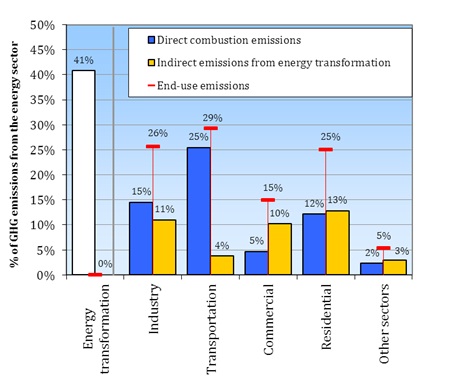The report, 'End-user GHG emissions from energy: Reallocation of emissions from energy industries to end users 2005-2009', demonstrates a new method of analysing the drivers of emissions by considering end user demand. The analysis redistributes 'indirect' emissions, mostly from oil refineries and plants generating electricity and heat, in order to calculate the overall emissions linked to each sector.
When the indirect emissions are considered, greenhouse gas emissions from the residential sector double (from 12 to 25 %) and the commercial sector trebles (from 5 to 15 %). Industry jumps from 15 to 26% when indirect emissions are factored in. Transport causes relatively small indirect emissions, pushing transport emissions from 25 to 29 %.
Changes in emissions 2008-2009
Between 2008 and 2009, energy-related emissions fell by 7 % in the EU. This dramatic fall has been attributed largely to the effect of the economic recession, a fact which is backed up by the new end use analysis. Between 2008 and 2009, greenhouse gas emissions reductions in industry accounted for two thirds of all energy-related emission reductions, when indirect emissions are included.
After industry, transport was the sector contributing most to the reduction in greenhouse gas emissions in 2009, in particular road transport. Part of this reduction in emissions on an end-use basis was accounted for by lower electric rail transport demand in 2009.
Greenhouse gas emissions caused by households and other services fell between 2008 and 2009. This was despite the colder winter - there was an increase in the number of ‘heating degree days’ in most European countries (an indicator of household demand for heating) compared to 2008. Although there was an increase in indirect emissions from heat and electricity used in homes in the EU, emissions from home heating appliances fell by a larger amount – leading to an overall decrease in end-use emissions from homes.
Objective of the report
The objective of this report is to help improve the understanding of past greenhouse gas (GHG) emission trends in the energy sector from the demand or end-user side. To do this, the report develops a methodology to redistribute emissions from energy industries to the final users (by sector) of that energy. This reallocation is done on the basis of Eurostat’s energy balances and GHG inventories for the energy sector as reported to the United Nations Framework Convention on Climate Change (UNFCCC), for the period 2005–2009.

'Energy transformation' refers to emissions from power plants, district heating plants, oil refineries, other large facilities and fugitive emissions.

Document Actions
Share with others